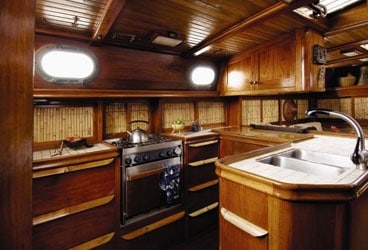
MakeoversRefitsST
Robbin Smith and Warren Moeller, artists and craftspeople, have incorporated countless clever innovations into the refit of Cuchara, the 1976 Westsail 43 that’s been their home and workshop for 16 years. For instance, the boat’s cockpit lockers were refit to become watertight load carriers. One is big enough to hold the many tools of their trade, even a band saw. The other locker has held 1,000 coconuts-which they use to create their artwork, which includes bowls and spoons-in the space that used to be a quarter berth. On deck, there are one-and-a-half-inch deck drains fitted with a Y-valve for rain collection that can be turned on and off from below. “Much better than the bucket dance,” says Warren, who also built in a hydraulic lifting engine-room door.
In the cockpit, Cuchara has a small, removable display screen that’s connected to the boat’s main computer “for watching our progress on our electronic chart,” says Warren. Cuchara’s cockpit is unique in that the autopilot head, engine gauges, and switches are just inside the companionway, not out in the spray. “Almost all the metal on deck we replaced with bronze,” says Warren. “We collected bronze off the hurricane wrecks in the Virgins, and I made a pattern for our stanchions that we had cast.”
Below, the main saloon has been stripped and redesigned for the needs of a couple with a high sense of style rather than for the seven or eight charterers accommodated in the boat’s original layout. It’s an interior in which most possessions aren’t visible. Hidden away behind sliding doors with bamboo slats are 20 shelved feet of art books, voluminous storage, all the navigation and communications equipment, a mini-desktop computer, and a flat-screen display, along with what Warren describes as “all the usual stuff that’s on any yacht.” Warren and Robbin collected the bamboo they used to build the doors for free in the jungle of the Chaguaramas region in Trinidad. Cuchara has more than 50 drawers with handmade bamboo handles. Every bit of teak they used to rebuild the boat came from plantations in Trinidad, not from the rain forest. “All drawers lock while under way with invisible sliding bolts that Robbin and I made from brazing rod and copper sheet,” says Warren. A main-saloon table transforms into a double bed for guests or nearly disappears to become a low-profile coffee table.
The forward master cabin is a peaceful refuge, complete with Buddhist altar and soothing lighting. On the bulkhead at the head of the bed are bamboo-covered switches that control individual fans; also mounted there is a bamboo-and-coconut reading light that Robbin and Warren made themselves.
The spacious, airy, and elegant galley has Italian-marble countertops. Continuous cold water is available from a special tap on the counter. Water is led from the tank through a carbon filter and 70 feet of copper tubing hidden in the refrigerator to the tap, and voila! A cold drink any time it’s wanted, without opening the fridge and releasing all the cold air.
The head is an oasis, displaying a hand-fabricated copper sink and graceful fixtures, most found as castoffs here and there and rehabilitated. The shower is larger than the one on a 60-foot Little Harbor, and in many ways it’s more beautiful and practical. Robbin made the “tiles” in the shower from a sheet of quarter-inch Plexiglas that she first sanded, cut into one-inch squares, then hand-set and grouted for the look of glass mosaic without the weight.
Cuchara is a piece of art handcrafted by artists in love with the traveling life under sail, and it’s a testament to how beautiful a cruising home can be when the imagination soars.
Bernadette Bernon, a Cruising World editor at large, spent six years cruising with her husband, Douglas. To read their stories from that voyage, visit the BoatU.S. website (www.boatus.com/cruising/ithaka).








